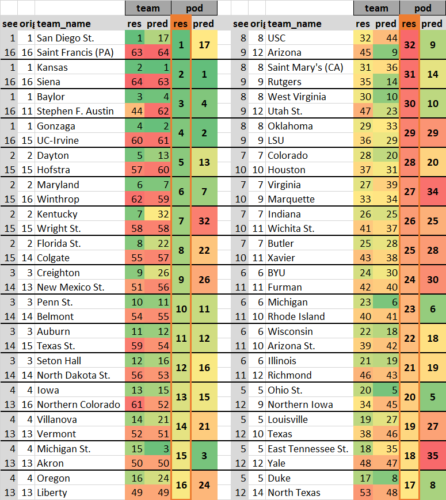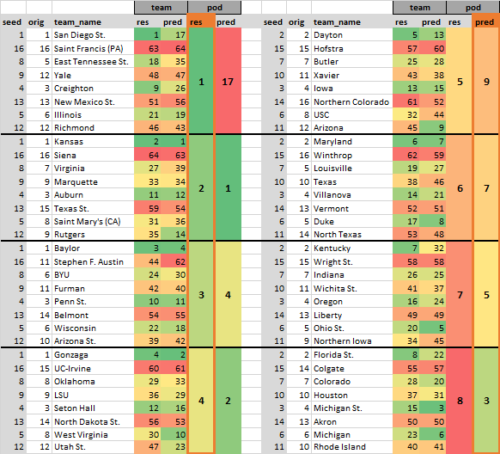Last year, I proposed a hybrid solution to seeding the NCAA Tournament, combining the aspiration to both reward strong resumes and maintain the integrity of the bracket–that is, actually giving higher seeds the better draw.
That post was lacking in clarity a bit, so here is an update aimed at making things a bit clearer and easier to understand.
The Goal
As a recap, our goal should be that teams with the best resumes get the most favorable draws. If the 64 tournament teams were ranked the same in both resume and team quality, things would be easy and we could just seed teams in that order. However, when those two rankings do not line up, we have to choose between ordering teams by resume versus giving better resumes a more favorable draw.
Here’s an example: let’s say we have a 4-team league. The Dominants went 3-0, the Pretty Goods went 2-1, the Luckys went 1-2 and the Bad Beats went 0-3. The Luckys beat the Bad Beats, but the Bad Beats are a much higher-quality team and neither the Dominants nor the Pretty Goods want to play them over the Luckys. What do we do? We have two choices:
- Seeds teams by the resume/record: This would put the Dominants #1, the Pretty Goods #2, the Luckys #3, and the Bad Beats #4.
- Create the most favorable path: In this scenario, the Dominants deserve the best draw and so we would move the Luckys to #4 and the Bad Beats to #3.
In the first scenario, the Luckys are rewarded with the higher seed over the Bad Beats, deservedly so as they finished with a better record. However, the Dominants are hurt in this scenario (with the Pretty Goods the beneficiary)–they’d prefer to be the #2 seed!
In the second scenario, we fix that–now the Dominants get what they deserve, the easiest draw. However, now it’s the Luckys who are unjustly hurt–they have to take the toughest draw even though they deserve to have an easier path than the Bad Beats.
As you can see, there’s no solution to satisfy everyone, so we have a decision to make. I don’t think there’s an objectively correct answer, it’s just a matter of subjective preference. But in my mind, I lean towards protecting the top resumes, meaning I’d opt for option 2.
The Methodology
Ok, onto the NCAA Tournament and a real-life example. (NOTE: I’m making one small tweak from my last post for simplicity and removing the 1st Round safeguard against teams moving more than 3 seed lines; this can easily be added back in.)
Each round will work like this:
- Rank teams/pods by their resume.
- Divide the pods in half.
- The top half of remaining pods are protected and stay in the order of their resume.
- The bottom half of pods are re-sorted by their (predictive) true strength. The easiest of these pods is paired with the best resume team (the #1 overall seed) down to the toughest pod being matched up with the worst of the protected pods.
- These matchups are now locked in and create new pods.
- Repeat for each round.
This will be clearer as we progress through an example. I’m using my own Achievement Score as the resume metric (it is a version of “Parcells“, from the “WAB” family of metrics, for those that follow Seth Burn) and my predictive ratings for team’s true strength.
Initial Ranking

We start with a ranking of teams from 1 to 64 based on their resume. Already, we can see some flaws–I doubt Ohio State is very happy about having to play Arizona (#9 true strength) while the team below them, Illinois, gets to play Stephen F. Austin (#62).
1st Round Matchups
So let’s do our first adjustment. The teams on the left (the top 32 resumes) are protected and we sort the teams on the right now by their team quality.

Okay, now Ohio State gets a much easier 1st Round matchup in #45 Northern Iowa, and a slightly better one than Illinois gets (#43 Richmond). Stephen F. Austin bears the brunt of this, as they drop all the way down a 16-seed to play Baylor since the Lumberjacks are the 3rd-worst team in the field.
These pairings are now locked in to what I’ll call “pods”. They cannot change, but the pods can move around, affecting their matchups in later rounds.
2nd Round Matchups


The first chart shows our initial 2nd Round matchups. The 1st Round matchups are now locked in, but we will now adjust the 2nd Round pairings. Again, the top half of remaining “pods” are protected–that is the top 4 seed lines in this iteration. The other pods (seeds 5 through 8) are re-ordered based on their pod strength (defined as the predictive ranking of the best team in the pod).
San Diego St. is our #1 overall team. To start this iteration they were paired with USC (#44 predictive ranking) and Arizona (#9). They say, no way we want to play Zona and instead look down the list and get paired up with the 5-12 matchup between ETSU (#35) and Yale (#47), which now becomes an 8-9 matchup. Note, however, that while ETSU gets moved to a worse seed here, they still keep their reward of being an original 5-seed and get to play Yale instead of Arizona, who USC (an original #8 seed) has to play.
Sweet 16 Matchups


Same as before, we’re down to 16 pods of 4 teams each. The top 8 pods (those headed up by the #1 and #2 seeds) are protected and the bottom 8 are re-ordered. Creighton is the top #3 seed (#9 overall resume), but they are no longer protected and are the weakest of the unprotected pods, so they move into San Diego State’s region. Nobody wants to play Michigan St., my #3 team in predictive rankings, so they (and their pod) move into FSU’s region as the Seminoles are the last of the protected pods.
Again, we see the benefits of the rolling matchups. Auburn is the 11th-best resume and now has to join the region of the #1 quality team, Kansas, while a worse resume team, Oregon, gets to draw Kentucky’s much more favorable pod. However, Auburn still has the easier 1st Round matchup compared to Oregon (#54 Texas State instead of #49 Liberty) and the easier 2nd Round matchup (#14 Rutgers instead of #5 Ohio State), so they do derive some reward from their better resume.
Elite 8 Matchups


Same thing here: San Diego State gets to swap out a pod with two top-6 teams and replace them with one where #9 Arizona is the best team, making their Elite 8 opponent a bit weaker. Dayton as the #5 overall resume is “hurt” here (they actually aren’t hurt in this exact scenario, since San Diego State is not as strong of a team as their resume indicates) but still has an easier draw in each of the first 3 rounds than #8 resume Florida State.
Final Four Matchups


Finally, we match up regions for their Final Four pairings. The top 2 overall seeds, SDSU and Kansas, are protected. In this example, Baylor and Gonzaga’s regions are flipped, allowing SDSU to choose the (slightly) more favorable of the two regions, thus avoiding Gonzaga and the two Michigan schools, all rated among the top 6 toughest teams.
The Final Bracket


Above are the initial bracket, seeded solely by resume, and the final “hybrid” bracket resulting from the above method.
Here’s a view of the progression, starting with the initial bracket in gray and moving inward. Teams in green are “protected” teams for that round, while teams in yellow are ones that were moved to a different pod during that iteration. You can follow SDSU and see how they were able to swap out their initial pod for an easier one at each stage:

- First, they went from Siena to Saint Francis (PA) as their 1st Round opponent.
- Next, they eliminated Arizona from their potential 2nd Round opponents and instead draw ETSU and Yale.
- For the Sweet 16, Ohio St. is a dangerous team, so they get moved out in favor of Creighton and Illinois.
- In the Elite 8, they have Michigan, Michigan St. and FSU in their path, but here get to swap them out for Arizona, Iowa, and Dayton.
- Finally, in the Final Four, they get two avoid Gonzaga’s region.
Creighton provides another good example of the balancing act going on here. They have the 9th-best resume, but rate just 26th in the predictive rankings. In the Sweet 16 iteration, they get moved from the best 3-seed to worst 4-seed. However, they get to keep their easy 1st round matchup vs New Mexico St. (the 56th-best team in the field) and 2nd round matchup against Illinois (#19), making their path to the Sweet 16 much easier. Michigan St., meanwhile, gets moved into Creighton’s slot as the top 3-seed, but has to play #50 Akron in the 1st round and potentially #6 Michigan in the 2nd.
Alternative structures
There are plenty of adjustments you could make to this structure. Again, it’s mostly a matter of personal preference. Here are some potential ones:
- Let protected teams pick their pod matchup instead of automatically assigning them. This is my favorite.
- As I mentioned in the previous article, you may want to calculate pod strength as the weighted true strength of the entire pod instead of just using the shortcut of the best team. This would be slightly more accurate.
- Also as mentioned earlier, you may want to provide a little bit of protection for the unprotected teams by limiting how far a team can fall (or rise) from their initial seeding. Any adjustment here will (slightly) hurt the better resume teams, so it is a trade off.
- You can, of course, use a different resume metric (ESPN’s Strength of Record (SOR), Wins Above Bubble (WAB), etc.) or predictive metric (KenPom, etc.). I just used my own as it was easier for me to code. You could even use a combination of metrics, just don’t mix resume metrics and predictive metrics together please (like the NET does)!
- You may need to include some safeguards to ensure some of the bracketing principles aren’t violated, such as two teams from the same conference playing early in the tournament.
- After the final bracket is set, you could then let teams also draft their location for the regional and the first weekend.
There are lots of minor tweaks that could potentially improve upon this. However, I think the main framework is the best way to combine rewarding strong resumes and maintaining the fairness and integrity of the bracket by giving the best resumes the most favorable path.
